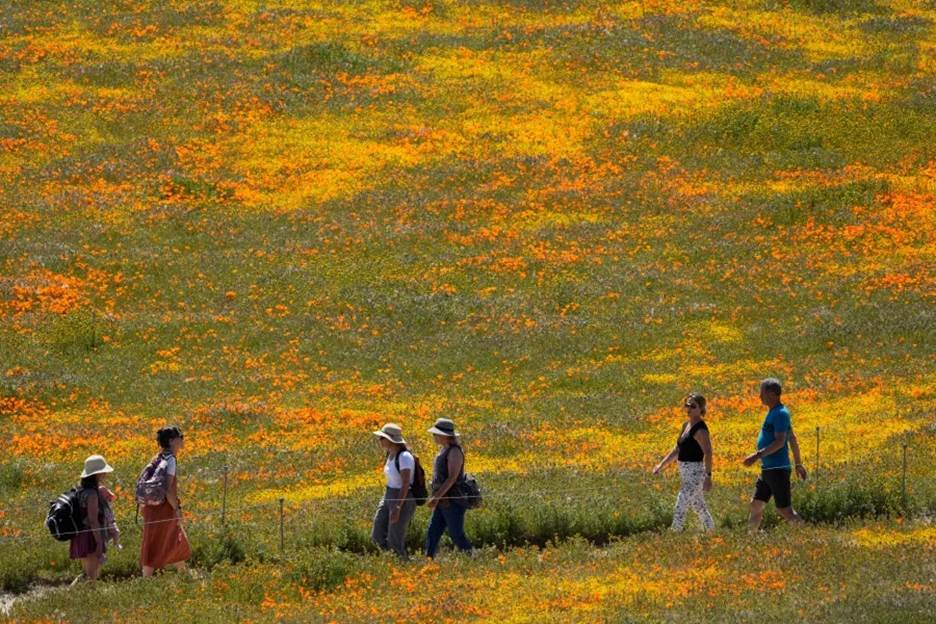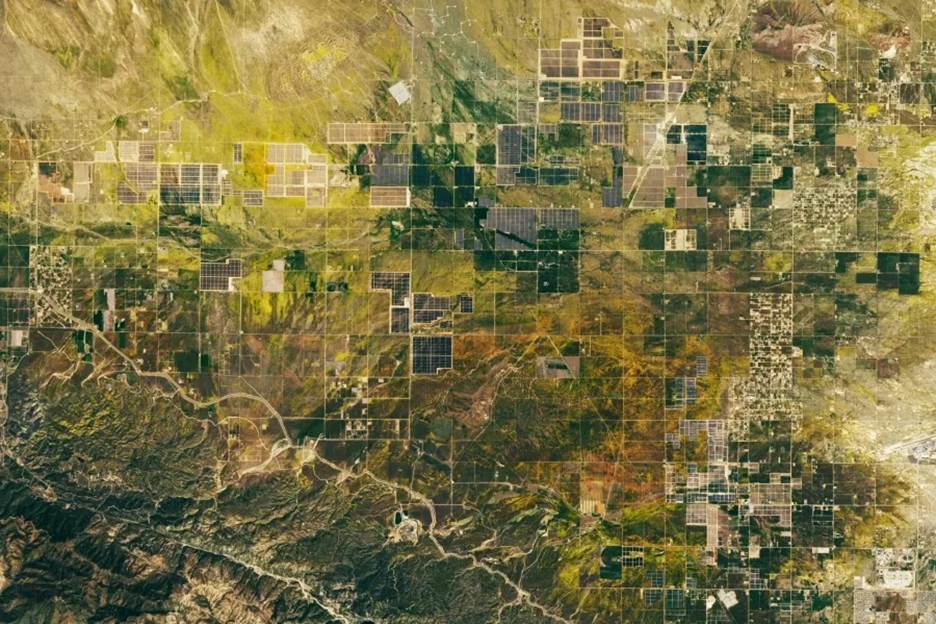
Visitors walk on a pathway amid fields of blooming flowers at the Antelope Valley California Poppy Reserve on April 10 in Lancaster, Calif. - AP Photo/Marcio Jose Sanchez
California Bursts iInto Wildflower ‘Super Bloom’ after Relentless Storms
By Sharon Udasin
After months of wintry weather battered the West Coast with torrential rains and snow, California’s hillsides are now bursting with orange, yellow and purple hues so vibrant that they are visible from space.
Tourists are coming in droves to see these so-called “super blooms,” which occur when large amounts of precipitation in natural landscapes intersect with years of drought , according to California’s Department of Parks and Recreation.
Prolonged drought conditions eliminated the grasses and weeds that would have otherwise consumed nutrients, enabling the growth of what the agency described as “spectacular blooms” — events that last occurred in 2019 and 2017.
“The seeds hang out for years and years in the soil. And when you get a good rain, they’re like, ‘Oh, okay, great, time to come out,’” Valerie Eviner, a plant sciences professor at the University of California Davis, told The Hill.
“So, we do tend to see those big flushes,” she said, noting that “super bloom” is more of a popular term.
Regardless of what they’re called, these colorful bursts of flowers are drawing hikers, photographers and zip-liners into their midst.
NASA’s Earth Observatory has also been capturing the spectacle from space, with the Landsat 9 satellite’s Operational Land Imager-2 depicting “ another vibrant view of the bloom ” just last weekend.

NASA’s Earth Observatory has also been capturing the spectacle from space
Alongside the images, the agency described how yellow flowers were beginning to “pop out” and replace the golden-orange poppies that had dominated the week before.
Wildflowers can now be seen up and down the state — a rare delight for Californians and out-of-state visitors alike.
Wildflower super blooms occur only sporadically in Southern California — where University of California ecologists had counted just 10 such events prior to this year, the agency noted.
Such blooms are still more uncommon in Northern California than in the drought-prone southern part of the state, because “good flower years are all about bad grass conditions,” according to Eviner.
The appearance of wildflowers in Northern California is “way more patchy” and tends to occur after disturbances such as fires “knock back some of the grasses,” she explained.
Because grass seeds don’t store in the soil from year to year, a big fire event will tend to yield “really good wildflowers” the next spring, Eviner added.
“The wildflower seeds, which are sitting in the soil, will be like, ‘Oh, nobody’s competing with us this year. It’s a good time to come out,’” she said.
When grasses fail to grow because of drought or fire, wildflowers can take their place as “emergency first responders” — by providing food for animals and preventing soil erosion, according to Eviner.
As climate-driven weather extremes continue to wreak havoc on the West, there are likely to be more hostile conditions that necessitate such an emergency response, she added.
Where to see the blooms
In Northern California, among the top Bay Area wildflower spots recommended by the Parks Department is Mount Tamalpais State Park — home to narrow leaf mule’s ear, lupine, Ithuriel’s spear, blue dicks, California poppy and Western blue-eyed grass.
Also, of interest is China Camp State Park , which could feature California poppy, narrowleaf mule’s ear, yellow mariposa lily, Ithuriel’s spear and Douglas iris.
This month and next could bring yellow mariposa lily, ookow, red larkspur and purple Chinese houses to Trione-Annadel State Park , as well as whispering bells, popcorn flowers, Diogenes’ lantern, blue dicks, lupine and California poppy to Sugarloaf Ridge State Park , per the Parks Department.
Eviner said she plans this weekend to visit one of her favorite flower destinations — Table Mountain near Oroville — about 75 miles north of Sacramento.
In Southern California, Anza-Borrego Desert State Park — about 70 miles northeast of San Diego — has already experienced some blooms, but the Parks Department warned that with hotter temperatures on the way, the wildflower season there is nearing its end.
The Antelope Valley California Poppy Reserve has likewise already “passed its peak,” the Parks Department stated, noting that “there are only a few more weeks to continue to view the vivid colors of orange from the poppies, pinks from filagree and vibrant yellows from the goldfields.”
At this popular destination — in Lancaster, Calif., about 70 miles north of Los Angeles — the Parks Department recommended the Antelope Trail, North Loop and Kitanemuk Vista Point as the prime spots where wildflower viewing is still available.
“We want to remind visitors to not expect an endless sea of bright orange poppies,” the agency warned.
Echoing these sentiments, Eviner said that when she visited the Carrizo Plain National Monument — east of San Luis Obispo — to see flowers over spring break, she heard visitors lamenting that there wasn’t as much variety as there was in 2017 and 2019.
While Eviner said that the landscape looked to her like a super bloom, she stressed that people have “different opinions” on the meaning of this decidedly non-scientific term.
Elsewhere in Southern California, the Parks Department recommended Chino Hills State Park for canterbury, school bell, arroyo lupine and California poppy viewing, and Colonel Allensworth State Historic Park , which is “currently covered in brilliant yellow goldfields.”
Another hot spot in Southern California touted by the Parks Department is Eastern Kern County Onyx Ranch State Vehicular Recreation Area , where visitors can enjoy “a beautiful array of wildflowers blooming for the next month including lavender Lacy Phacelia and brilliant yellow desert dandelions.”
The Parks Department also suggested Red Rock Canyon State Park for its dandelions, blue dicks, desert or wild parsley and red maids, as well as Tule Elk State Natural Reserve , for its goldfields, filagree and occasional elk herd.
A call for care
As people head out to see the flowers in the coming weeks, the Los Angeles-based Theodore Payne Foundation for Wild Flowers and Native Plants urged visitors to take care when viewing this “awe-inspiring natural phenomenon.”
Crowds were so tremendous in the town of Lake Elsinore’s popular Walker Canyon this February that city officials decided to prohibit access to those trails and threatened arrest for noncompliance, the Los Angeles Times reported.
Emphasizing that wildflowers are “delicate and are easily damaged by human activity,” the Payne Foundation asked that tourists “minimize the impact on fragile ecosystems.”
Eviner shared similar advice, noting that when these plants are at peak flower, they have yet to disperse their seeds.
This means that when “we’re walking all over them, we’re essentially crushing the ability to provide those seeds for the next super bloom,” she warned.
“The ideal is always sticking to the trail,” Eviner said. “But I’d say, if you really need to be in those flowers, just go a foot or so in from the trail.” - The Hill.

